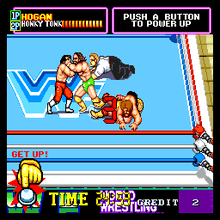WWF Superstars
WWF Superstars is an arcade game manufactured by Technōs Japan and released in 1989. It is the first WWF arcade game to be released. A series of unrelated games with the same title were released by LJN for the original Game Boy. Technōs followed the game with the release of WWF WrestleFest in 1991.
| WWF Superstars | |
|---|---|
 Arcade flyer | |
| Developer(s) | Technōs Japan |
| Publisher(s) | Technōs Japan |
| Director(s) | Yoshihisa Kishimoto |
| Platform(s) | Arcade |
| Release |
|
| Genre(s) | Professional wrestling |
| Mode(s) | Single-player Up to 2 players (simultaneous) |
| Cabinet | Upright |
| Arcade system | CPU: 68000 and Z80 with a YM2151 and an M6295 for sounds. |
| Display | Raster resolution 456x336 |
Features
The game features some of the signature moves and trademark mannerisms of the wrestlers in the game. There are also cut scenes featuring Ted DiBiase, André the Giant and Virgil. Mean Gene Okerlund and Miss Elizabeth make appearances as well. Before the first match, the player's chosen team enters the arena via the "ring cart" seen at WrestleManias III and VI.
Gameplay

Players select two wrestlers to form a tag team. The playable wrestlers are Hulk Hogan, "Macho Man" Randy Savage, The Ultimate Warrior, Big Boss Man, "Hacksaw" Jim Duggan, and The Honky Tonk Man. Up to two players can play at once. The players take their team through a series of matches with other tag teams in New York City and then Tokyo.
The game features a basic grappling and attack system. From a grapple, a player can either toss the opponent, throw them into the ropes, or go into a headlock from which two character-specific grapple moves can be performed. Each wrestler also possesses standing strikes, running attacks, running counterattacks, ground attacks, and moves from the top turnbuckle. A referee is present in the ring, but cannot be attacked or otherwise affected by the wrestlers.
It is also possible to brawl outside of the ring, provided the player reenters before a count of 20. There, a table can be picked up and swung at opponents. If both wrestlers go outside the ring at once, their tag team partners automatically jump out to join the fight. Occasionally one of these partners will wander off screen and return wielding a folding chair. Neither the chair nor table can be taken inside the ring.
After three matches are won, players get to challenge the Mega Bucks ("The Million Dollar Man" Ted DiBiase and André the Giant) for the final round. Most grapple moves do not work against André because of his immense size. The Mega Bucks are not selectable characters. However, there are cheats for MAME that allow them to be used (together or separately), the drawback being that if DiBiase or André get a submission victory, the game will think that the player lost. Also, there can sometimes be graphical errors which will make the in-ring opponent disappear.
If the player wins the title match, a newspaper headline heralding the players' tag team as champions is shown. The player is then taken through another series of three matches (one of which will feature DiBiase) in the other city and a final match against DiBiase and André before the game ends.
Reception
In Japan, Game Machine listed WWF Superstars on their November 1, 1989 issue as being the third most-successful table arcade unit of the year.[1]
See also
- List of licensed wrestling video games
- List of fighting games
References
- "Coin-Op Museum: WWF Superstars". Retrieved December 8, 2005.
- "WWF Superstars FAQ v3.0". Retrieved December 8, 2005.
- WWF Superstars gameplay footage
- Game Director Yoshihisa Kishimoto
- "Game Machine's Best Hit Games 25 - テーブル型TVゲーム機 (Table Videos)". Game Machine (in Japanese). No. 367. Amusement Press, Inc. 1 November 1989. p. 29.